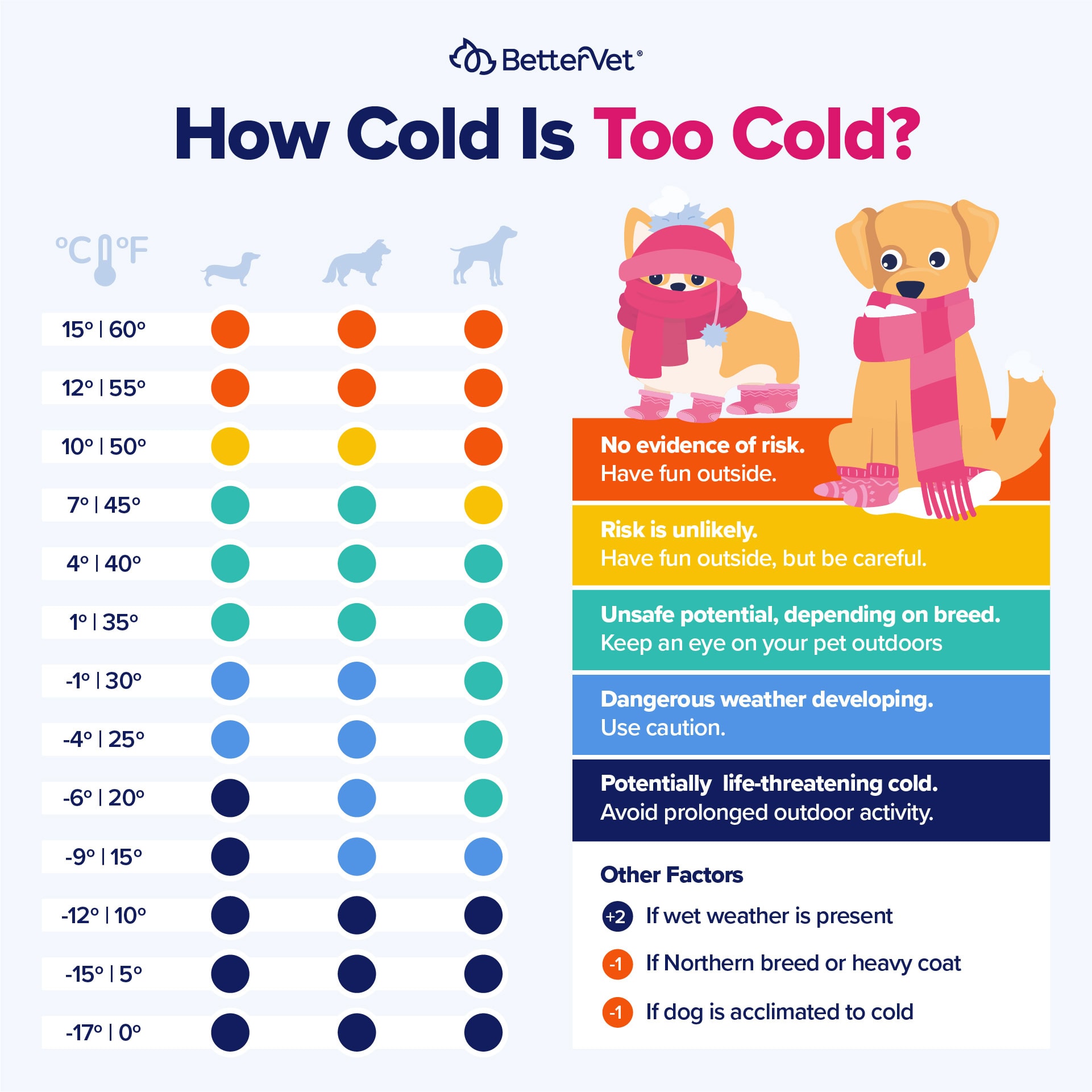If you click on links we provide, we may receive compensation.
As the leaves fall and temperatures drop, many dog owners find themselves asking, ‘How cold is too cold for my dog?‘.
It’s a valid concern as we want to keep our furry friends safe and comfortable during winter walks. Understanding your dog’s tolerance to cold and how to protect them from chilly weather is vital.
Let’s explore when it might be too cold to walk your dog and how to keep them cozy when the mercury dips.
When is it Too Cold to Walk Your Dog?
The specific temperature at which it becomes too cold for a dog walk varies based on breed, size, age, and health status of your pet. For smaller breeds or dogs with short hair, they can start feeling cold at temperatures under 45 degrees Fahrenheit. Extreme caution should be exercised in temperatures below 20 degrees Fahrenheit.
However, veterinarians often suggest that if it’s too cold for you to comfortably remain outside, it’s likely too cold for your dog as well.
What Happens When a Dog Gets Too Cold?
When a dog gets too cold, it can start to show signs of hypothermia. These include shivering, lethargy, and a decrease in body temperature. If left untreated, hypothermia can lead to severe complications like heart problems and kidney failure. In the worst cases, it can even be fatal.
Here are signs your dog might be cold during a walk:
Shivering or Trembling: This is a clear sign that your dog might be cold. They’re trying to generate heat by shivering.
Slow Movements or Stopping: If your dog seems reluctant to walk or keeps stopping, they might be too cold.
Whining or Anxiety: Some dogs might show signs of discomfort or stress when they’re cold.
Seeking Shelter: If your dog is trying to find a place to hide or get away from the cold, they’re likely too cold.
Cold Ears and Body: If your dog’s ears or body feel unusually cold, they’re probably too cold.
It is crucial to observe your pet for indications of cold stress, such as shivering or reluctance to continue walking, during colder weather.
But what temperature is considered too cold for my dog?
Dog Walk Temperature Chart
Individual dogs may have different tolerances based on factors like coat type, breed, age, and overall health status.
Here’s a basic dog walking temperature chart to provide guidance.
| Temp (°F) | Small Dog* | Medium/Large Dog | Risk |
|---|---|---|---|
| Above 45 | Comfortable | Comfortable | Low |
| 32 – 45 | Potential Discomfort | Comfortable | Moderate for Small Dogs |
| 20 – 32 | High Risk | Potential Discomfort | High for Small Dogs, Moderate for Large Dogs |
| Below 20 | Extreme Risk | High Risk | Extreme Risk for All Dogs |
*Small dogs are generally considered to be under 15 pounds, while medium/large dogs are over 15 pounds.

Always monitor your dog for signs of cold stress and consult with a veterinarian if you have any concerns.
Tips for Walking Your Dog in Cold Weather
Now, if you do take your pup on a walk when its cold outside, it’s important to keep them comfortable, warm, and safe.
Here’s a few tips to safely walk your dog outside in cold weather:
Dress Your Dog Appropriately: Sweaters, jackets, and boots can provide additional warmth. Make sure they fit well and are comfortable for your dog.
Keep Walks Short: In colder temperatures, aim for shorter, more frequent walks instead of long ones.
Choose the Right Time: If possible, walk your dog during the warmest part of the day.
Avoid Ice: Ice can be cold and slippery. Salt and other ice-melting chemicals can also irritate your dog’s paws.
Check Their Paws: Ice, snow, and salt can get stuck in your dog’s paws. Check and clean them after each walk.
Keep Them Dry: If your dog gets wet, dry them off as soon as possible to prevent heat loss.
Always monitor your dog during walks. If they show signs of being too cold, end the walk and bring them indoors.

QUMY Dog Shoes for Large Dogs, Medium Dog Boots & Paw Protectors for Winter Snowy Day, Summer Hot Pavement, Waterproof in Rainy Weather, Outdoor Walking, Indoor Hardfloors
34,015
$28.99
Tips for Walking Your Dog in Cold Weather
Now, if you do take your pup on a walk when its cold outside, it’s important to keep them comfortable, warm, and safe.
Here’s a few tips to safely walk your dog outside in cold weather:
Dress Your Dog Appropriately: Sweaters, jackets, and boots can provide additional warmth. Make sure they fit well and are comfortable for your dog.
Keep Walks Short: In colder temperatures, aim for shorter, more frequent walks instead of long ones.
Choose the Right Time: If possible, walk your dog during the warmest part of the day.
Avoid Ice: Ice can be cold and slippery. Salt and other ice-melting chemicals can also irritate your dog’s paws.
Check Their Paws: Ice, snow, and salt can get stuck in your dog’s paws. Check and clean them after each walk.
Keep Them Dry: If your dog gets wet, dry them off as soon as possible to prevent heat loss.
Always monitor your dog during walks. If they show signs of being too cold, end the walk and bring them indoors.
Dog Breeds With High Cold Tolerance
Some breeds are better equipped to handle cold temperatures due to their size, coat type, and general breed characteristics.
Here are a few cold weather dog breed examples:
Siberian Husky: These dogs are bred for the cold and can tolerate temperatures as low as -60 degrees Fahrenheit.
Alaskan Malamute: Similar to Huskies, these dogs are also bred for cold climates and can handle temperatures well below freezing.
Bernese Mountain Dog: These large, sturdy dogs have a thick double coat that allows them to tolerate cold temperatures.
Newfoundland: These dogs have a heavy, water-resistant coat that allows them to tolerate extremely cold weather.
Samoyed: Bred to live in cold climates, these dogs have a dense coat that can handle freezing temperatures.
While certain breeds can handle cold weather better, prolonged exposure to extreme cold can be dangerous for any dog. Always watch for signs of discomfort or hypothermia, regardless of breed.
Frequently Asked Questions
How cold is too cold for dog paws?
Many veterinarians suggest that below 20 degrees Fahrenheit, the risk of cold injury such as frostbite increases significantly. The pads of a dog’s paws can be sensitive to cold, salt, and ice-melting chemicals. Therefore, it’s important to protect their paws during cold weather with dog-friendly booties, or by applying a paw balm to prevent cracks and dryness. Always check your dog’s paws after a winter walk for any signs of injury or discomfort.
What temperature do dogs get cold?
It’s generally accepted that small dogs, dogs with thin coats, and very young or old dogs can start to feel cold at temperatures around 45 degrees Fahrenheit. Larger dogs or breeds with thicker coats might start feeling uncomfortable when the temperature drops below 20 degrees Fahrenheit.
Do dogs feet feel the cold?
Yes, a dog’s feet can certainly feel the cold. The pads on a dog’s feet, although tougher than human skin, can be sensitive to cold temperatures, snow, ice, and de-icing salts. Prolonged exposure to these elements can lead to discomfort, dryness, cracks, and in severe cases, frostbite.
Wrapping Up: Navigating Winter Walks with Your Dog
As we’ve discovered, there’s no one-size-fits-all answer to when it’s too cold for a dog walk. Factors like breed, size, age, and health status all come into play.
Remember, if it’s too cold for you, it’s likely too cold for your dog.
It’s essential to know the signs of cold stress in your pet and act promptly to prevent complications. Ensuring your dog is appropriately dressed, keeping walks short, and caring for their paws can help keep them warm and safe.
Above all, your observant eye and intuitive understanding of your dog’s comfort are the best tools to navigate the winter weather.
Happy winter walking!





